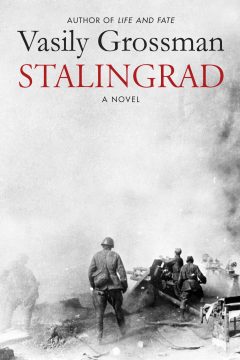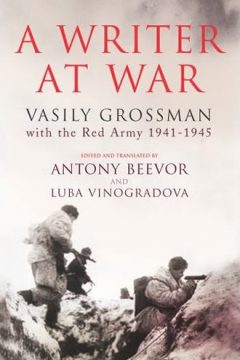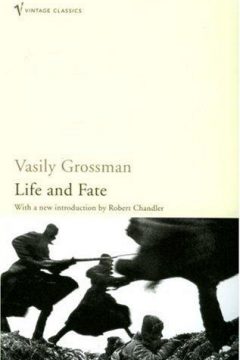The Road
 Vasily Grossman (Estate)
Vasily Grossman (Estate)
Short fiction and articles
Translated from the Russian by Robert and Elizabeth Chandler with Olga Mukovnikova
Vasily Grossman is recognised as one of the outstanding literary figures of the twentieth century, best known as the author of the novel Life and Fate. The short fiction and essays collected here are at least as accomplished, and illustrate the remarkable breadth of his work: The Road, an account of the war from the point of view of a mule in an Italian artillery regiment, can be read as a 4000 word distillation of Life and Fate; In the Town of Berdichev (the author’s first published success, which won the admiration of Maksim Gorky and Isaak Babel) is the story of a woman commissar who has to choose between her new-born baby and her Red Army comrades; Mama is based on a true story about an orphaned girl who was adopted by Nikolay Yezhov (head of the N.K.V.D. at the height of the Great Terror).
In addition to the eleven stories, this volume includes two letters Grossman wrote to his mother after her death, and three articles, including the complete text of The Hell of Treblinka, one of the very first, and still among the most powerful, descriptions of a Nazi extermination camp.
Grossman’s stories – works of satire, comedy, tragedy and pure narrative – read like descriptions of real events, drawing as they do on the human detail of Russia’s turbulent twentieth century. They demonstrate one by one the old intelligence, delicate irony and extraordinary vividness for which Grossman has justly become renowned.
The Road contains the following short stories and articles:
THE TOWN OF BERDICHEV (1934) – Grossman’s first short story. During the civil war, a female commander or “lady in leathers” discovers that she is pregnant. After several attempts to get rid of the child, she is resolute to take a months leave, and goes to stay in a village. Having had the baby, she is overtaken by a maternal instinct and decides not to re-join the army. However, the town is attacked and taken over by the enemy. The last soldiers of the resistance are leaving for the forest, and the new mother feels that her duty is to follow them. She leaves the baby in the village and joins the partisans.
A SMALL LIFE (1936) – Engineer Orlov hardly ever goes out. He is respected at work, but his wife is the centre of his universe. The couple take an orphan girl into their house for the holidays. The girl appears strong and streetwise, much tougher then her foster family.
A YOUNG WOMAN AND AN OLD WOMAN (1943) – Two women meet on the way to a holiday resort. The old one belongs to the revolutionary generation. She lost her husband and daughter to the repressions, her life seems to be over and she is reconciled with this fact. She is observing her colleagues’ successful careers and personal happiness and feels no jealousy. In a stange turn of events, the young woman looses her mother and husband within months, whilst the older one receives notification of her daughter’s case review. She is not so resolute to withdraw from life anymore.
THE OLD MAN (1943) – A placid old man lives in a village occupied by the Germans. He listens to the stories of woe told by his fellow villagers, and experiences first-hand the cruelty of the occupying soldiers. Eventually, he turns to violence and murders a soldier.
THE OLD TEACHER (1943) – A small town is taken over by the Germans. Some of the inhabitants collaborate. The situation for the Jews of the town is worsening by the minute. An old teacher, known and respected by the whole town, is taking care of a widow and her family, who have been thrown out of their apartment. Even surrounded by people, he is painfully lonely. Finally, a massacre takes place. All the Jews are murdered, and the town folk rise to shame the collaborators.
THE HELL OF TREBLINKA (1944) – This essay was used during the Nurnberg process. It is an investigation into the existence of the death camp that was demolished in 1943. The Nazis tried to hide evidence of the mass murder there. However, many witness accounts make it impossible for them to deny the horrific crimes.
THE SISTINE MADONNA (1955) – Rafael’s Sistine Madonna was among the paintings taken from Dresden art gallery by the Red army. The author admires the picture in the Pushkin museum. The image of a young mother and a child who are prepared to follow their fate obediently makes him think of Treblinka.
THE ELK (1956) – A dying academic has become completely dependent upon his wife. She is a devoted carer, but on the day that he feels that his death will come, she does not return home. The only object with which he able to engage in his last moments is the stuffed head of an elk that he has shot and mounted on the wall many years before.
MAMA (1960) – A girl named Nadya is taken from an orphanage for the children of the enemies of the people. Her new foster father is the head of state security, Comrade Ezhov. When fortunes change for Ezhov and he is arrested, she is back at square one. Nadya grows up in a distant orphanage. The memories of her former privileged life are as distant to her as images of her real parents.
LIVING SPACE (1960) – A woman spent many years in the Gulag and was rehabilitated in a room in Moscow after having been proven innocent. She had no friends, and no one in her building knew her well. After her death, the room is quickly given to another family. One day an important letter arrives for her with details of her husband’s death. The new residents give the case little thought; the woman and her story are insignificant to all those around her.
THE ROAD (1961-1962) – The war as seen through the eyes of a mule. He is transported from country to country, and everywhere he goes unbearable work and hunger await him. The little warmth shown him by another animal helps him to survive.
THE DOG (1960-1961) – A stray dog is taken into a clinic as a lab pet. It is trained to take part in space flight experiments. The dog recognizes the chief scientist as her master, and to his surprise, the scientist is fond of the mutt. The dog is destined to be the first one to see open space. When the dog returns, the doctor looks for signs of eternity in her eyes, but there is only madness.
IN KISLOVODSK (1962-1963) – Bon vivant, a doctor of a prestigious holiday resort in Kislovodsk stays behind during the evacuation and finds himself in the city occupied by the Germans. He treats Russian captives, and his life almost gets back to its normal genteel ways. After a short time, however, an SS commander orders him to kill all his patients. The doctor commits suicide.
THREE LETTERS (1950; 1961) – Two Letters from Vasily to his mother, written in 1950 and 1961. His mother was killed by the Nazis in 1941. The letters speak to her of his feelings of love towards her which continue as strongly as ever since her death, and of the way that he sees his life as he ages. The third letter referred to (but not actually included in the collection) is the chapter from Life and Fate now often referred to as ‘The Last Letter’ – the letter that Anna Semyonovna, a fictional portrait of Grossman’s mother, writes to her son and manages to have smuggled out of the ghetto.
ETERNAL REST (1957-1960) – An essay about Vagankovskiy cemetery in Moscow. It is as difficult to receive a plot of land there as to get a permanent registration in Moscow. Short stories of ordinary lives and deaths prove that death often becomes a solution to complicated relationships and family conflicts.
The Sistine Madonna and Eternal Rest were published in 2011 by Editions Agra in Greece







